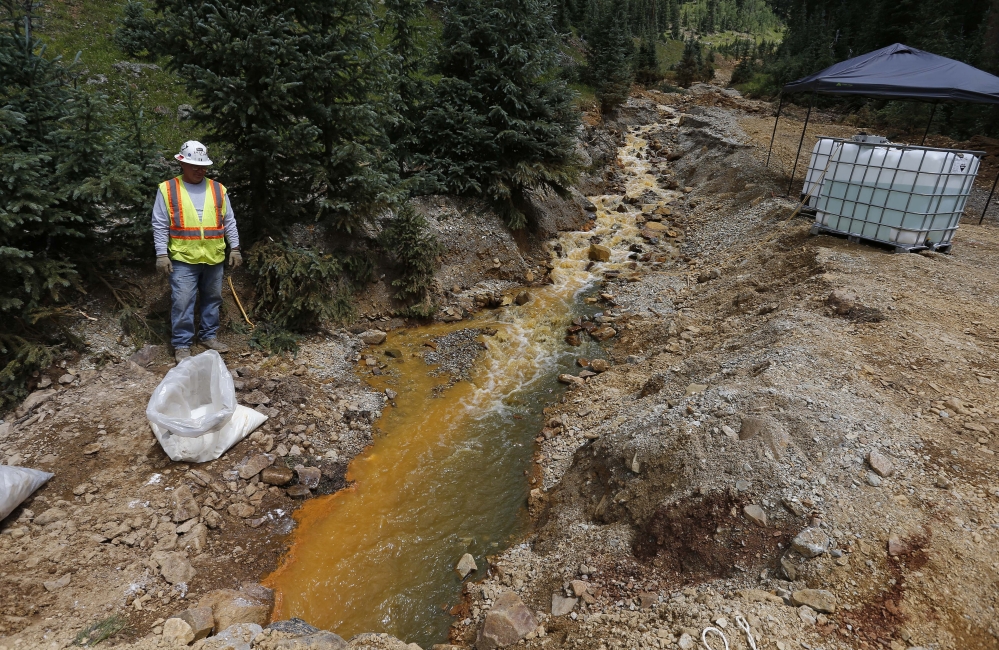SILVERTON, Colorado — It will take many years and many millions of dollars simply to manage and not even remove the toxic wastewater from an abandoned mine that unleashed a 100-mile-long torrent of heavy metals into Western rivers and has likely reached Lake Powell, experts said Thursday.
Plugging Colorado’s Gold King Mine could simply lead to an eventual explosion of poisonous water elsewhere, so the safest solution, they say, would be to install a treatment plant that would indefinitely clean the water from Gold King and three other nearby mines. It would cost millions of dollars, and do nothing to contain the thousands of other toxic streams that are a permanent legacy of mining across the nation.
Federal authorities first suggested a treatment plant for Gold King more than a decade ago, but local officials and owners of a nearby mine were reluctant to embrace a federally-sponsored cleanup.
“They have been not pursuing the obvious solution,” said Rob Robinson, a retired abandoned mines cleanup coordinator for the U.S. Bureau of Land Management. “My hope is this has embarrassed the hell out of them and they’re going to finally take it seriously.”
The Gold King delay illustrates a problem dwarfing the 3 million-gallon waste plume accidentally released by contractors working for the U.S. Environmental Protection Agency: There are about 500,000 abandoned mines nationwide, and only a fraction have been dealt with, despite decades of effort.
EPA has estimated the cost of cleaning up abandoned mines nationwide, not including coal mines, at between $20 billion and $54 billion.
Many of the abandoned mines – including in the Silverton area where Gold King is located – were developed after an 1872 federal mining law encouraged development and allowed people to lay claim to minerals beneath public lands.
They’ve since become legacies of the industry’s boom-bust cycles, in which companies fold up operations when metals prices fall, leaving behind sources of toxic wastewater that chronically leave rivers barren and taint drinking water supplies.
Of the abandoned mines in the U.S., more than 48,000 had been inventoried through the BLM’s Abandoned Mine Lands program, which began after new federal laws focused on environmental protection in the 1960s, 1970s and early 1980s.
But only about one in five of the inventoried mines is being cleaned up or requires no more action. More than 38,000 await further analysis or work, according to the bureau.
Under the federal Clean Water Act, the mine owner is supposed to control discharges, but Gold King’s landowner, Todd Hennis, is not considered legally responsible for the cleanup because the mine stopped operating in 1923, long before the modern era of environmental protection.
“A lot of these are Mom and Pops, they’ve inherited the property or they bought it years ago before the environmental laws were passed, and they just don’t have the resources,” said Doug Jamison, with the hazardous materials division at Colorado’s state health department.
In Colorado alone, there are hundreds, possibly thousands of abandoned mines discharging acid rock drainage, Jamison said. The potent stew of heavy metals accumulates as chemical reactions brew up sulfuric acid at concentrations high enough to dissolve steel, and leach poisons decades after mines close.
Send questions/comments to the editors.



Success. Please wait for the page to reload. If the page does not reload within 5 seconds, please refresh the page.
Enter your email and password to access comments.
Hi, to comment on stories you must . This profile is in addition to your subscription and website login.
Already have a commenting profile? .
Invalid username/password.
Please check your email to confirm and complete your registration.
Only subscribers are eligible to post comments. Please subscribe or login first for digital access. Here’s why.
Use the form below to reset your password. When you've submitted your account email, we will send an email with a reset code.